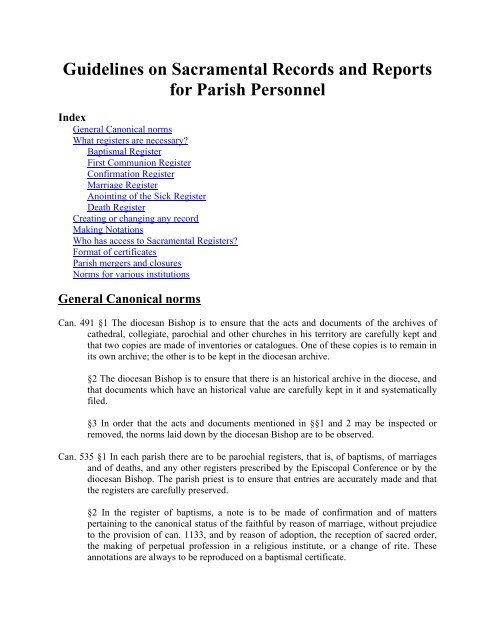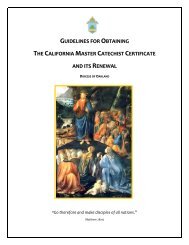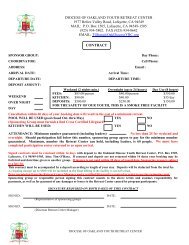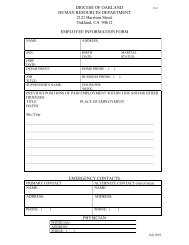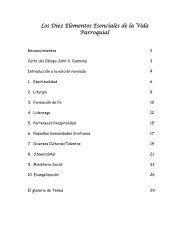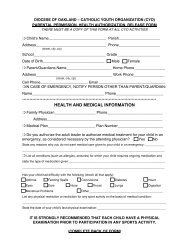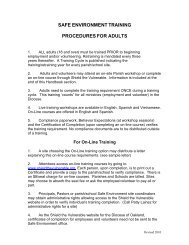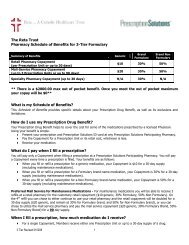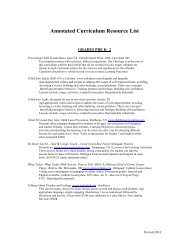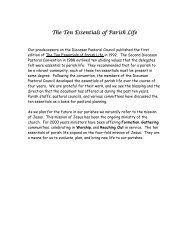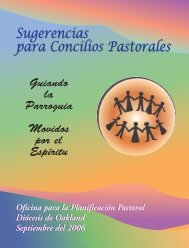Guidelines on Sacramental Records and Reports for Parish Personnel
Guidelines on Sacramental Records and Reports for Parish Personnel
Guidelines on Sacramental Records and Reports for Parish Personnel
Create successful ePaper yourself
Turn your PDF publications into a flip-book with our unique Google optimized e-Paper software.
<str<strong>on</strong>g>Guidelines</str<strong>on</strong>g> <strong>on</strong> <strong>Sacramental</strong> <strong>Records</strong> <strong>and</strong> <strong>Reports</strong><br />
<strong>for</strong> <strong>Parish</strong> Pers<strong>on</strong>nel<br />
Index<br />
General Can<strong>on</strong>ical norms<br />
What registers are necessary?<br />
Baptismal Register<br />
First Communi<strong>on</strong> Register<br />
C<strong>on</strong>firmati<strong>on</strong> Register<br />
Marriage Register<br />
Anointing of the Sick Register<br />
Death Register<br />
Creating or changing any record<br />
Making Notati<strong>on</strong>s<br />
Who has access to <strong>Sacramental</strong> Registers?<br />
Format of certificates<br />
<strong>Parish</strong> mergers <strong>and</strong> closures<br />
Norms <strong>for</strong> various instituti<strong>on</strong>s<br />
General Can<strong>on</strong>ical norms<br />
Can. 491 §1 The diocesan Bishop is to ensure that the acts <strong>and</strong> documents of the archives of<br />
cathedral, collegiate, parochial <strong>and</strong> other churches in his territory are carefully kept <strong>and</strong><br />
that two copies are made of inventories or catalogues. One of these copies is to remain in<br />
its own archive; the other is to be kept in the diocesan archive.<br />
§2 The diocesan Bishop is to ensure that there is an historical archive in the diocese, <strong>and</strong><br />
that documents which have an historical value are carefully kept in it <strong>and</strong> systematically<br />
filed.<br />
§3 In order that the acts <strong>and</strong> documents menti<strong>on</strong>ed in §§1 <strong>and</strong> 2 may be inspected or<br />
removed, the norms laid down by the diocesan Bishop are to be observed.<br />
Can. 535 §1 In each parish there are to be parochial registers, that is, of baptisms, of marriages<br />
<strong>and</strong> of deaths, <strong>and</strong> any other registers prescribed by the Episcopal C<strong>on</strong>ference or by the<br />
diocesan Bishop. The parish priest is to ensure that entries are accurately made <strong>and</strong> that<br />
the registers are carefully preserved.<br />
§2 In the register of baptisms, a note is to be made of c<strong>on</strong>firmati<strong>on</strong> <strong>and</strong> of matters<br />
pertaining to the can<strong>on</strong>ical status of the faithful by reas<strong>on</strong> of marriage, without prejudice<br />
to the provisi<strong>on</strong> of can. 1133, <strong>and</strong> by reas<strong>on</strong> of adopti<strong>on</strong>, the recepti<strong>on</strong> of sacred order,<br />
the making of perpetual professi<strong>on</strong> in a religious institute, or a change of rite. These<br />
annotati<strong>on</strong>s are always to be reproduced <strong>on</strong> a baptismal certificate.
§3 Each parish is to have its own seal. Certificates c<strong>on</strong>cerning the can<strong>on</strong>ical status of the<br />
faithful, <strong>and</strong> all acts which can have juridical significance, are to be signed by the parish<br />
priest or his delegate <strong>and</strong> secured with the parochial seal.<br />
§4 In each parish there is to be an archive, in which the parochial books are to be kept,<br />
together with Episcopal letters <strong>and</strong> other documents which it may be necessary or useful<br />
to preserve. On the occasi<strong>on</strong> of visitati<strong>on</strong> or at some other opportune time, the diocesan<br />
Bishop or his delegate is to inspect all of these matters. The parish priest is to take care<br />
that they do not fall into unauthorized h<strong>and</strong>s.<br />
§5 Older parochial registers are also to be carefully safeguarded, in accordance with the<br />
provisi<strong>on</strong>s of particular law.<br />
Can. 876 To prove that baptism has been c<strong>on</strong>ferred, if there is no c<strong>on</strong>flict of interest, it is<br />
sufficient to have either <strong>on</strong>e unexcepti<strong>on</strong>able witness or, if the baptism was c<strong>on</strong>ferred<br />
up<strong>on</strong> an adult, the sworn testim<strong>on</strong>y of the baptized pers<strong>on</strong>.<br />
Can. 894 To establish that c<strong>on</strong>firmati<strong>on</strong> has been c<strong>on</strong>ferred, the provisi<strong>on</strong>s of can. 876 are to be<br />
observed.<br />
Can. 1573 The depositi<strong>on</strong> of <strong>on</strong>e witness cannot amount to full proof, unless the witness is a<br />
qualified <strong>on</strong>e who gives evidence <strong>on</strong> matters carried out in an official capacity, or unless<br />
the circumstances of pers<strong>on</strong>s <strong>and</strong> things persuade otherwise.<br />
What registers are necessary?<br />
Each parish is required to keep the following sacramental registers: Baptism, C<strong>on</strong>firmati<strong>on</strong>,<br />
Marriage, <strong>and</strong> Death (Can<strong>on</strong> 535). Besides the records prescribed in Can<strong>on</strong> Law, the Diocese of<br />
Oakl<strong>and</strong> requires that the parish maintains a register of First Communi<strong>on</strong>s. <strong>Parish</strong>es may also<br />
maintain a record of “Sick Calls” or Anointing of the Sick.<br />
<strong>Sacramental</strong> registers are permanent, historical records. Care should be taken to purchase<br />
registers of quality care <strong>and</strong> binding. Use of the alphabetized list at the beginning of each register<br />
is also str<strong>on</strong>gly encouraged. Although computerized files may be c<strong>on</strong>venient <strong>for</strong> indexing needs,<br />
these are NEVER to be c<strong>on</strong>sidered an acceptable substitute <strong>for</strong> the original h<strong>and</strong>written<br />
registers. The original h<strong>and</strong>written <strong>Sacramental</strong> Registers are to be kept permanently. They are<br />
never to be destroyed.<br />
<strong>Sacramental</strong> records are c<strong>on</strong>fidential in<strong>for</strong>mati<strong>on</strong>. Registers should be kept in a safe secure place<br />
in the parish, <strong>and</strong> should not be removed, copied, or loaned without the approval of the<br />
chancellor of the diocese. When a parish is suppressed, the parish registers are maintained in the<br />
archives of the Diocese of Oakl<strong>and</strong>. When a parish is merged, the resulting parish maintains the<br />
registers of all merged parishes.<br />
It is recommended that separate registers be purchased <strong>and</strong> maintained <strong>for</strong> missi<strong>on</strong> churches,<br />
oratories, <strong>and</strong> chapels. This is useful when these churches are raised to the status of parish or<br />
when care of a missi<strong>on</strong> or chapel is transferred to a different parish.
Special registers, which are available from private vendors, are required. A parish may retain<br />
separate registers or combined registers, depending <strong>on</strong> the needs of the parish.<br />
The sacramental registers are to be stored in a locked place, preferably <strong>on</strong>e which is fire-proof or<br />
fire-resistant. The loss or destructi<strong>on</strong> of any sacramental register should be reported immediately<br />
to the Chancellor’s Office or the Tribunal.<br />
The Baptism Register<br />
Can<strong>on</strong>s relevant to Baptism Registers include: 296, 852, 869, 870, 873, 874, 877, 878, <strong>and</strong> 1685.<br />
The baptismal register is the primary record <strong>for</strong> recording a pers<strong>on</strong>’s status within the church<br />
(Can<strong>on</strong> 535.2). The baptismal register entry is to include:<br />
1. The Christian name(s) of the child as designated by the parent(s)/adoptive parents; or<br />
the legal name of the adult (always use the maiden name of a woman);<br />
2. The name of the father (first, middle if any, <strong>and</strong> surname) <strong>and</strong> the name of the mother<br />
(first, middle if any, <strong>and</strong> maiden name); or names of adoptive parents;<br />
3. The date <strong>and</strong> place of birth;<br />
4. The name(s) of the sp<strong>on</strong>sor(s);<br />
5. The place <strong>and</strong> date of the baptism; <strong>and</strong><br />
6. The name of the minister per<strong>for</strong>ming the baptism.<br />
Notati<strong>on</strong>s are to be entered in the baptismal registers <strong>for</strong> c<strong>on</strong>firmati<strong>on</strong>, marriage, <strong>and</strong> holy orders.<br />
Even if these sacraments are c<strong>on</strong>ferred at the same parish, the notati<strong>on</strong>s are to be recorded in the<br />
baptismal register <strong>and</strong> the corresp<strong>on</strong>ding index. Additi<strong>on</strong>al notati<strong>on</strong>s to the register include those<br />
regarding religious professi<strong>on</strong>, c<strong>on</strong>diti<strong>on</strong>al baptisms, rites supplied, annulments, laicizati<strong>on</strong>s,<br />
change of rite, <strong>and</strong> dispensati<strong>on</strong> of vows.<br />
Certificates are to be issued as so<strong>on</strong> as possible after the event is recorded in the register. A<br />
routine baptismal certificate is to include all in<strong>for</strong>mati<strong>on</strong> of a public nature, but may not include<br />
any c<strong>on</strong>fidential notati<strong>on</strong>s (such as references made to adopti<strong>on</strong> or legitimacy). An official<br />
baptismal certificate is to be signed, dated, <strong>and</strong> sealed. The secti<strong>on</strong>s <strong>for</strong> c<strong>on</strong>firmati<strong>on</strong> <strong>and</strong><br />
marriage (sometimes <strong>on</strong> the reverse of the <strong>for</strong>m) are to be completed as notati<strong>on</strong>s indicate. If<br />
there are no notati<strong>on</strong>s, it should be completed with the phrase “n<strong>on</strong>e recorded.”<br />
A state birth certificate is to be used as the supporting documentati<strong>on</strong> <strong>for</strong> the baptismal register<br />
entry. If this is not possible to obtain, the hospital record can be used to verify the date of birth<br />
<strong>and</strong> parents names. Entering in<strong>for</strong>mati<strong>on</strong> in the baptismal register based <strong>on</strong> verbal statement<br />
al<strong>on</strong>e can be problematic, <strong>and</strong> may result in the recording of inaccurate in<strong>for</strong>mati<strong>on</strong> <strong>and</strong> the<br />
creati<strong>on</strong> of inauthentic records.<br />
Sp<strong>on</strong>sors / Godparents<br />
In some cases, it is customary <strong>for</strong> the baptized to have multiple sp<strong>on</strong>sors. When this occurs the<br />
register <strong>and</strong> certificates are to list <strong>on</strong>ly two. The parents of the baptized are to choose the
sp<strong>on</strong>sors that are to be listed in the register, keeping in mind that at least <strong>on</strong>e sp<strong>on</strong>sor must be a<br />
c<strong>on</strong>firmed, active Catholic, over the age of 16, with no can<strong>on</strong>ical impediments (Can<strong>on</strong> 874.2).<br />
Church law (can. 874§2) allows a baptized pers<strong>on</strong> who is not a member of the Catholic Church,<br />
to serve as "a Christian witness." The designati<strong>on</strong> "CW" might be useful <strong>for</strong> clarity. Church law<br />
(Ecumenical Directory # 98b) holds that a baptized Eastern Orthodox is properly a godparent<br />
<strong>and</strong> not a Christian witness.<br />
In cases when the parents of the baptized request new “godparents” some time after the baptism<br />
has taken place, it may be explained that the parents may chose any<strong>on</strong>e to assist with the faith<br />
development of an individual but that does not alter who witnessed the baptism; there<strong>for</strong>e, the<br />
register may not be changed.<br />
Proxy Godparents<br />
When a godparent or sp<strong>on</strong>sor appoints a proxy to participate in the rite of baptism, both names<br />
should be entered in the register, with "Proxy" written after that pers<strong>on</strong>'s name. No more than<br />
two godparents are allowed.<br />
Ascripti<strong>on</strong> to the proper Church Sui Iuris<br />
Ascripti<strong>on</strong> to an Eastern Rite Catholic Church sui iuris, (e.g., Byzantine, Mar<strong>on</strong>ite) is determined<br />
by the rite of the father, not by the rite of the minister or parish of baptism, unless the pers<strong>on</strong> is<br />
14 years of age or older, at which age the individual can choose his/her rite. Thus, when a Latin<br />
priest or deac<strong>on</strong> baptizes some<strong>on</strong>e who by law is ascribed to an Eastern Catholic Church, a<br />
notati<strong>on</strong> must be made in the "Notati<strong>on</strong>s" column as to the proper Rite of the pers<strong>on</strong>. (can. 111)<br />
Unwed parents<br />
The name of the mother is to be entered in the register if there is public proof of her maternity<br />
(e.g. the birth certificate) or if she states this in writing or be<strong>for</strong>e two witnesses (Can<strong>on</strong> 877). The<br />
name of the father is to be inserted <strong>on</strong>ly if there is public proof (e.g., the birth certificate) or by<br />
his own sworn declarati<strong>on</strong> be<strong>for</strong>e the pastor <strong>and</strong> two witnesses. If no public proof is available<br />
the name of the father or the mother is not recorded. The phrase “father unknown”, or “mother<br />
unknown” is to be used. The certificate issued from this entry will record the appropriate phrase.<br />
The use of the phrase “illegitimate” is not recommended. Supporting documentati<strong>on</strong> is to be kept<br />
in the permanent files of the parish archives <strong>and</strong> include appropriate cross-references.<br />
Professi<strong>on</strong> of Faith<br />
A professi<strong>on</strong> of faith is to be recorded in the Baptism Register with a notati<strong>on</strong> “professi<strong>on</strong> of<br />
faith.” The data c<strong>on</strong>cerning the Rite of Recepti<strong>on</strong> should be entered in the spaces provided <strong>for</strong><br />
baptism, <strong>and</strong> the data c<strong>on</strong>cerning the original baptism should be entered in the "Notati<strong>on</strong>s"<br />
column, especially the date <strong>and</strong> place. Special care must be taken to follow this procedure when<br />
young children are received into full communi<strong>on</strong> al<strong>on</strong>g with their parents. In these cases, it is<br />
suggested that the cerem<strong>on</strong>ies be supplied as in an emergency baptism, so there is a <strong>for</strong>mal<br />
recepti<strong>on</strong> into the Church. If first communi<strong>on</strong> <strong>and</strong> c<strong>on</strong>firmati<strong>on</strong> are received at the same time, the<br />
name of the pers<strong>on</strong> making the professi<strong>on</strong> is to be recorded in all of the appropriate registers,<br />
cross-referencing as appropriate.
For the "full recepti<strong>on</strong> into the Church" celebrated <strong>for</strong> a baptized adult, the following in<strong>for</strong>mati<strong>on</strong><br />
is to be entered in the Baptismal Register:<br />
1. The given <strong>and</strong>/or Christian name(s) of the pers<strong>on</strong> (always use the maiden name of a<br />
woman);<br />
2. The name of the father (first, middle if any, <strong>and</strong> surname) <strong>and</strong> the name of the mother<br />
(first, middle if any, <strong>and</strong> maiden name);<br />
3. The date <strong>and</strong> place of birth;<br />
4. The name of the sp<strong>on</strong>sor;<br />
5. The date <strong>and</strong> place of professi<strong>on</strong> of faith;<br />
6. The name of the minister who received the pers<strong>on</strong>’s professi<strong>on</strong> of faith;<br />
7. Marginal notati<strong>on</strong> giving the date <strong>and</strong> place of the original baptism, recepti<strong>on</strong> of<br />
Eucharist <strong>and</strong> c<strong>on</strong>firmati<strong>on</strong>, <strong>and</strong> marital status (either current valid marriage or the<br />
c<strong>on</strong>validati<strong>on</strong> of the current marriage). Any declarati<strong>on</strong> of invalidity (including where<br />
granted <strong>and</strong> protocol number) should be noted.<br />
Similar in<strong>for</strong>mati<strong>on</strong> is also recorded <strong>for</strong> the celebrati<strong>on</strong> of the Baptism of an adult.<br />
Emergency Baptism<br />
When baptism occurs in an emergency situati<strong>on</strong>, either at home or in an instituti<strong>on</strong> such as a<br />
hospital, notificati<strong>on</strong> is to be sent to, <strong>and</strong> the register is to be completed at the parish of the<br />
parents of the baptized (in cases of infant baptism) or at the parish in which the individual resides<br />
(in cases of adult baptism). The register is to be completed as outlined <strong>for</strong> ordinary baptism. In<br />
cases when rites are supplied at the proper parish in the future, the date of baptism to be listed in<br />
the register is the date the “emergency baptism” took place. The words “rites supplied” <strong>and</strong> the<br />
date of the completi<strong>on</strong> of the celebrati<strong>on</strong> are to be listed in the remarks column.<br />
Adopti<strong>on</strong><br />
It is recommended that baptism not take place until after the child is <strong>for</strong>mally adopted <strong>and</strong> the<br />
birth certificate is issued. The entry in these cases should include: the full name of the child as<br />
designated by the adopting parent(s), full names of the adopting parent(s), date <strong>and</strong> place of<br />
birth, names of the sp<strong>on</strong>sors, <strong>and</strong> the name of the minister per<strong>for</strong>ming the baptism.<br />
When baptism occurs prior to adopti<strong>on</strong>, the notati<strong>on</strong> made in the original entry is to include the<br />
statement “Adopti<strong>on</strong>. Do not issue this record. See entry X, page X”. The new entry is to list the<br />
legal name of the individual, the names of the adopting parents <strong>and</strong> the name of the minister who<br />
c<strong>on</strong>ferred the sacrament. The new entry is not to include the names of the witnesses or sp<strong>on</strong>sors<br />
of the baptism. The new certificate issued from this record is to include <strong>on</strong>ly the names of the<br />
adopting parents, the child’s legal name, the date <strong>and</strong> place of baptism, <strong>and</strong> the name of the<br />
minister who c<strong>on</strong>ferred the sacraments. The names of the sp<strong>on</strong>sors <strong>and</strong> any noted remarks are not<br />
to be entered <strong>on</strong> the certificate.<br />
Supporting documentati<strong>on</strong> <strong>for</strong> the new entry would include a copy of the revised birth certificate<br />
issued by the state <strong>and</strong> the adopti<strong>on</strong> decree. These documents are to be kept in the permanent<br />
files of the parish archives <strong>and</strong> are to include references to the appropriate register <strong>and</strong> entry<br />
number.
If the original baptismal record was made in a parish other than the adopting parents' parish, an<br />
entry is to be made in the register of the adoptive family’s parish citing the locati<strong>on</strong> of the<br />
original record, <strong>and</strong> list <strong>on</strong>ly the names of the adopting parents <strong>and</strong> date <strong>and</strong>s place of birth. The<br />
certificate is to be issued from this entry.<br />
On October 20, 2000, the USCCB issued norms under can. 877, §3 <strong>for</strong> the purpose of assisting<br />
those with the resp<strong>on</strong>sibility of recording the baptism of children who had been adopted or who<br />
later are adopted. These norms were originally passed <strong>on</strong> November 18, 1998, <strong>and</strong> in turn<br />
received Roman approbati<strong>on</strong> <strong>on</strong> September 30, 2000.<br />
C<strong>on</strong>diti<strong>on</strong>al Baptism<br />
When a c<strong>on</strong>diti<strong>on</strong>al baptism is c<strong>on</strong>ferred, "Baptized c<strong>on</strong>diti<strong>on</strong>ally" is to be written in the<br />
"Notati<strong>on</strong>s" column. Otherwise the entry is the same as <strong>for</strong> any other baptism. By virtue of can<strong>on</strong><br />
869, §2, baptisms in other faiths are presumed valid until the c<strong>on</strong>trary is dem<strong>on</strong>strated.<br />
There<strong>for</strong>e, <strong>on</strong>ly after careful investigati<strong>on</strong> <strong>and</strong> with a positive doubt remaining as to the fact of a<br />
baptism or its valid celebrati<strong>on</strong>, a pers<strong>on</strong> is c<strong>on</strong>diti<strong>on</strong>ally baptized. This c<strong>on</strong>diti<strong>on</strong>al baptism is<br />
d<strong>on</strong>e privately (i.e., no fanfare <strong>and</strong> <strong>on</strong>ly the essential participants). In such cases the date <strong>and</strong><br />
place of baptism should be noted instead of the purported earlier baptism. A note as to its<br />
c<strong>on</strong>diti<strong>on</strong>al celebrati<strong>on</strong> should be included.<br />
The First Communi<strong>on</strong> Register<br />
The Diocese prescribes the use of the First Communi<strong>on</strong> register. The entry is to include:<br />
1. The legal <strong>and</strong> Christian names of the child;<br />
2. The date <strong>and</strong> place of baptism;<br />
3. The church <strong>and</strong> date of the first Communi<strong>on</strong>;<br />
4. The name of the main celebrant of the Mass.<br />
A current copy of the baptismal certificate is required as supporting documentati<strong>on</strong>. A certificate<br />
is to be issued as so<strong>on</strong> as possible after the event is recorded in the register.<br />
The C<strong>on</strong>firmati<strong>on</strong> Register<br />
Can<strong>on</strong>s relevant to C<strong>on</strong>firmati<strong>on</strong> Registers include: 894 - 896.<br />
The C<strong>on</strong>firmati<strong>on</strong> register entry is to include:<br />
1. The legal <strong>and</strong> Christian names of the child or adult (use maiden name of a woman);<br />
2. The name of the father (first, middle if any, <strong>and</strong> surname) <strong>and</strong> the name of the mother<br />
(first, middle if any, <strong>and</strong> maiden name);<br />
3. The date <strong>and</strong> place of baptism;<br />
4. The name of the sp<strong>on</strong>sor selected by the pers<strong>on</strong>;<br />
5. The place <strong>and</strong> date of the c<strong>on</strong>firmati<strong>on</strong>; <strong>and</strong><br />
6. The name of the minister per<strong>for</strong>ming the c<strong>on</strong>firmati<strong>on</strong>.
A copy of the baptism certificate is required as supporting documentati<strong>on</strong>. A c<strong>on</strong>firmati<strong>on</strong><br />
certificate is to be issued as so<strong>on</strong> as possible after the event is recorded in the register. In cases of<br />
joint celebrati<strong>on</strong>s, as those per<strong>for</strong>med at the Cathedral, each parish which sends c<strong>and</strong>idates is<br />
resp<strong>on</strong>sible <strong>for</strong> the completi<strong>on</strong> of its own register, which is to include the name of the parish in<br />
which the celebrati<strong>on</strong> took place. Notificati<strong>on</strong> of the recepti<strong>on</strong> of this sacrament is to be sent to<br />
the place of baptism. The date <strong>and</strong> place of the recepti<strong>on</strong> of this sacrament is to be noted in the<br />
baptism register even if the sacrament took place in the same parish.<br />
The Marriage Register<br />
Can<strong>on</strong>s relevant to Marriage Registers include: 1081, 1121, 1122, 1123, <strong>and</strong> 1685.<br />
The marriage register entry is to include:<br />
1. The legal names of the groom;<br />
2. The name of the father (first, middle if any, <strong>and</strong> surname) <strong>and</strong> the name of the mother<br />
(first, middle if any, <strong>and</strong> maiden name) of the groom;<br />
3. The legal names of the bride (Always use the maiden name of a woman, even if a<br />
sec<strong>on</strong>d marriage);<br />
4. The name of the father (first, middle if any, <strong>and</strong> surname) <strong>and</strong> the name of the mother<br />
(first, middle if any, <strong>and</strong> maiden name) of the bride;<br />
5. The date <strong>and</strong> place (actual church <strong>and</strong> town) of the wedding;<br />
6. The names of the witnesses;<br />
7. The name of the priest/deac<strong>on</strong>/minister asking <strong>for</strong> <strong>and</strong> receiving the couple’s vows;<br />
8. Notati<strong>on</strong> of any permissi<strong>on</strong>s, dispensati<strong>on</strong>s <strong>and</strong> delegati<strong>on</strong>s obtained <strong>for</strong> the valid<br />
celebrati<strong>on</strong> of the wedding (including protocol number if existing).<br />
It is the resp<strong>on</strong>sibility of the officiant to promptly file any <strong>and</strong> all civil documents with the<br />
appropriate county. The sacramental certificate is to be issued as so<strong>on</strong> as possible after the<br />
marriage has been recorded, <strong>and</strong> notificati<strong>on</strong> of the marriage sent to the place of baptism of the<br />
Catholic party (parties). The date <strong>and</strong> place of the recepti<strong>on</strong> of this sacrament is to be recorded in<br />
the baptismal register, even if the place of the baptism is the same parish as the place of<br />
marriage.<br />
Marriages are to be recorded in the register of the parish at which the cerem<strong>on</strong>y takes place. In<br />
cases where the cerem<strong>on</strong>y occurs in the chapel of an instituti<strong>on</strong>, the marriage is to be recorded in<br />
the parish in which the instituti<strong>on</strong> resides. In cases where a wedding is celebrated with<br />
dispensati<strong>on</strong> from can<strong>on</strong>ical <strong>for</strong>m, record of the marriage is found at the parish in which<br />
marriage preparati<strong>on</strong> took place <strong>and</strong> which requested the dispensati<strong>on</strong> <strong>and</strong> at the Chancery of the<br />
diocese that granted the dispensati<strong>on</strong> (Can<strong>on</strong> 1121.1). The prenuptial file or marriage data<br />
envelope is to be kept at the parish in which the preparati<strong>on</strong> took place. Notificati<strong>on</strong> of the<br />
marriage is to be sent to the place of baptism of the Catholic party by the party resp<strong>on</strong>sible <strong>for</strong><br />
marriage preparati<strong>on</strong>.
The index of the marriage register is to be arranged alphabetically by the last names of both<br />
spouses. The <strong>for</strong>mat is “male surname/female surname. The name to be used <strong>for</strong> the bride’s<br />
surname is that which is found <strong>on</strong> her baptismal certificate or, if not baptized, her ‘maiden’ legal<br />
name.<br />
The Prenuptial Investigati<strong>on</strong> file<br />
The prenuptial investigati<strong>on</strong> file or marriage data envelope created <strong>for</strong> the marriage is to be<br />
retained in the permanent files of the parish archives. The outside of the envelope may indicate<br />
the correlating register entry number. Supporting documentati<strong>on</strong> in the prenuptial file or<br />
“marriage envelope” includes the current (dated less than six m<strong>on</strong>ths prior to request) baptismal<br />
certificates <strong>for</strong> baptized parties, completed prenuptial <strong>for</strong>ms, civil marriage license, civil<br />
marriage certificate (in cases of a c<strong>on</strong>validati<strong>on</strong>), death certificate (when necessary), a copy of a<br />
dispensati<strong>on</strong> or permissi<strong>on</strong> (when necessary), any additi<strong>on</strong>al prenuptial <strong>for</strong>ms or documentati<strong>on</strong><br />
required by the parish (e.g., engaged encounter certificate). A copy of the civil marriage license,<br />
after it is signed by the parties, witnesses, <strong>and</strong> celebrant, may be included.<br />
C<strong>on</strong>validati<strong>on</strong><br />
When a marriage is c<strong>on</strong>validated, the data c<strong>on</strong>cerning the c<strong>on</strong>validati<strong>on</strong> are to be placed in the<br />
usual columns. The date, place <strong>and</strong> official of the original cerem<strong>on</strong>y are to be noted in the<br />
"Notati<strong>on</strong>s" column.<br />
Sanati<strong>on</strong><br />
When a marriage is sanated, the data c<strong>on</strong>cerning the original cerem<strong>on</strong>y are to be placed in the<br />
usual columns. The date, diocese <strong>and</strong> protocol number of the Sanati<strong>on</strong> are to be noted in the<br />
"Notati<strong>on</strong>s" column.<br />
Marriages of pers<strong>on</strong>s who are baptized or received into full communi<strong>on</strong> in the Catholic Church<br />
are not to be recorded in the Marriage Register, unless the marriage now is being c<strong>on</strong>validated or<br />
sanated. A notati<strong>on</strong> c<strong>on</strong>cerning the marriage is to be placed in the pers<strong>on</strong>'s baptismal record, in<br />
the "Notati<strong>on</strong>s" column.<br />
Dispensati<strong>on</strong>s, Permissi<strong>on</strong>s, Annulments<br />
When a dispensati<strong>on</strong> is granted prior to marriage, or an annulment is granted after marriage, the<br />
date, diocese <strong>and</strong> protocol number, al<strong>on</strong>g with the type of dispensati<strong>on</strong> (e.g., "Dispensati<strong>on</strong> from<br />
Disparity of Worship") or the word "Annulment" (with the diocese granting <strong>and</strong> protocol<br />
number), are to be noted in the "Notati<strong>on</strong>s" column (See can. 1081). Any special recording<br />
directi<strong>on</strong>s c<strong>on</strong>tained in the dispensati<strong>on</strong> or annulment document are to be followed.<br />
The Anointing of the Sick Register<br />
Some parishes maintain a record of the sacrament of the Anointing of the Sick that are<br />
administered by the priests in the parish. This record may include those that are d<strong>on</strong>e<br />
individually or in the communal rites. If this register is kept, it is left to the discreti<strong>on</strong> of the<br />
pastor or parochial administrator what in<strong>for</strong>mati<strong>on</strong> is to be included therein.
The Death Register<br />
Can<strong>on</strong>s relevant to Death Registers include: 1182.<br />
Although death is not a sacrament, a register is kept <strong>and</strong> it includes:<br />
1. The legal <strong>and</strong> Christian names of the pers<strong>on</strong>;<br />
2. The residential address of the deceased pers<strong>on</strong>;<br />
3. The date of death;<br />
4. The date <strong>and</strong> place of burial;<br />
5. Presider at the services.<br />
Notati<strong>on</strong>s may include additi<strong>on</strong>al in<strong>for</strong>mati<strong>on</strong> such as next of kin, age, whether anointed, name<br />
of funeral home, <strong>and</strong> cause of death. In cases where the funeral rites are celebrated in another<br />
parish, it is suggested that notificati<strong>on</strong> be sent to the pastor of the deceased. In the event that the<br />
funeral rites do not include a Mass at the parish but <strong>on</strong>ly a service at the funeral home, an entry<br />
may be made in the death register if the pers<strong>on</strong> is c<strong>on</strong>sidered a parishi<strong>on</strong>er. In the event the<br />
parish priest is attending a funeral service as a representative member of the clergy but the<br />
individual does not have a c<strong>on</strong>necti<strong>on</strong> to the parish, no entry is made.<br />
When the body has been cremated, no reference to the date or place of cremati<strong>on</strong> is made in the<br />
Death Register. However, the fact of cremati<strong>on</strong> should be noted as well as the date <strong>and</strong> place of<br />
the ashes' interment.<br />
Creating or changing any record<br />
How are entries made?<br />
Creating a sacramental record is a documentary service per<strong>for</strong>med by the Church. <strong>Sacramental</strong><br />
records also have importance as legal documents. The pastor or parochial administrator is<br />
resp<strong>on</strong>sible <strong>for</strong> proper maintenance of the registers. However, he may delegate the day-to-day<br />
administrati<strong>on</strong> of the records to a resp<strong>on</strong>sible pers<strong>on</strong> such as the parish secretary or business<br />
manager. (Can<strong>on</strong> 535)<br />
Recording sacramental entries should be d<strong>on</strong>e promptly <strong>and</strong> accurately. (Can<strong>on</strong> 877) In<strong>for</strong>mati<strong>on</strong><br />
should be entered in neatly imprinted letters not cursive h<strong>and</strong>writing. A good quality black ink<br />
pen should be used. Do not use pencil, colored ink, or felt-tipped marker. Never repair the pages<br />
with scotch tape.<br />
Discursive material should not be written in sacramental registers. Such material or related<br />
documents (e.g., civil records, corresp<strong>on</strong>dence) should be retained securely in a file in the parish<br />
archives. However, discreti<strong>on</strong> must be exercised in deciding which material to place in this file;<br />
not everything has to be retained. This file should be marked "<strong>Sacramental</strong> <strong>Records</strong>," <strong>and</strong> the
words "See <strong>Sacramental</strong> <strong>Records</strong> File" should be printed in the "Notati<strong>on</strong>s" column of the<br />
sacramental register.<br />
Printing the name of the m<strong>on</strong>th is preferred to using the m<strong>on</strong>th's number (e.g. “August” or “Aug”<br />
rather than "8").<br />
As registers become worn, they are to be rebound by a professi<strong>on</strong>al binder. Only if a register is<br />
bey<strong>on</strong>d repair may the records be transferred to a new register. The original register is to be<br />
retained in as safe a c<strong>on</strong>diti<strong>on</strong> as possible.<br />
Changes to entries<br />
Once entered into a sacramental register, data is c<strong>on</strong>sidered official <strong>and</strong> permanent. It may not be<br />
modified except under special c<strong>on</strong>diti<strong>on</strong>s, as detailed below. Original data should never be<br />
scratched out, erased, "whited out" or otherwise destroyed or obliterated.<br />
Minor changes (e.g., correcting a misspelling) may be made directly to the original entry. Such<br />
changes are to be made by drawing a straight, simple line through the word, number or letter to<br />
be changed <strong>and</strong> printing the change immediately above or below it.<br />
Major changes (e.g., to record an adopti<strong>on</strong> after baptism) may require that a new entry be<br />
created. In these cases, the original entry is to be preserved without change; a new entry, with all<br />
the data from the original entry reproduced (except the relevant change or changes), is to be<br />
made in the same register as close to the original entry as possible; both entries, as well as<br />
listings in the index, are to be cross-referenced; "Do Not Issue Certificate from This Record" is<br />
to be printed carefully across the face of the original entry.<br />
An insubstantial error (e.g., misspelling) may be corrected up<strong>on</strong> request of those pers<strong>on</strong>s who<br />
have a right to a certificate, as menti<strong>on</strong>ed in the secti<strong>on</strong> below. More significant errors <strong>and</strong> other<br />
changes require authentic supporting documentati<strong>on</strong>. Such documentati<strong>on</strong> will ordinarily c<strong>on</strong>sist<br />
of an original, "raised seal" certificate from a civil or ecclesiastical office, court, agency, etc. The<br />
issuing agency, date of the certificate <strong>and</strong> any protocol number should be printed in the<br />
"Notati<strong>on</strong>s" column of the register. When an error involves data pertaining directly to the<br />
celebrati<strong>on</strong> of a sacrament (e.g., date, identity of godparent) or rite of Christian burial such that<br />
no external verifying documentati<strong>on</strong> exists, the written or oral testim<strong>on</strong>y of a reputable witness<br />
will suffice.<br />
Some permitted changes<br />
- correct name (misspelling)<br />
- correct date<br />
- new legal name<br />
- adoptive parent(s)<br />
Some n<strong>on</strong>-permitted changes - “new” godparents or sp<strong>on</strong>sors<br />
- n<strong>on</strong>-adoptive stepparents<br />
- customary name or nickname
Once specific data has been changed in the sacramental register, the original data is not<br />
transcribed <strong>on</strong>to certificates (e.g., the natural parents’ names after adopti<strong>on</strong>).<br />
Removal of entries<br />
A parish occasi<strong>on</strong>ally will receive a notificati<strong>on</strong> from an individual or a church indicating that<br />
the pers<strong>on</strong> is no l<strong>on</strong>ger a Catholic <strong>and</strong> even asking that her/his name be removed from Catholic<br />
Church records. While it is appropriate to remove the pers<strong>on</strong>'s name from the parish membership<br />
roles (register), no changes are made to the sacramental records.<br />
The P<strong>on</strong>tifical Council <strong>for</strong> Legislative Texts <strong>on</strong> March 13, 2006, issued Actus Formalis<br />
Defecti<strong>on</strong>is ab Ecclesia Catholica which gives specific guidelines <strong>on</strong> the requirements necessary<br />
in order <strong>for</strong> a pers<strong>on</strong> to make an act of <strong>for</strong>mal defecti<strong>on</strong> from the Church. Please c<strong>on</strong>tact the<br />
Can<strong>on</strong> Law Department <strong>for</strong> further in<strong>for</strong>mati<strong>on</strong> if this situati<strong>on</strong> arises.<br />
Other notati<strong>on</strong>s<br />
Religious Professi<strong>on</strong><br />
<strong>Records</strong> relating to the professi<strong>on</strong> of perpetual vows are maintained by individual Orders.<br />
Notificati<strong>on</strong> of the professi<strong>on</strong> of perpetual vows is sent to the place of baptism. The date <strong>and</strong><br />
place of professi<strong>on</strong>, the name of the religious instituti<strong>on</strong>, <strong>and</strong> the name of witness to the vows (if<br />
provided) are to be noted in the baptismal register.<br />
Holy Orders<br />
The date <strong>and</strong> place of ordinati<strong>on</strong> as well as the name of the Ordinary c<strong>on</strong>ferring the sacraments<br />
are sent to the recipient's place of baptism where it is to be noted in the baptismal register.<br />
Separate notati<strong>on</strong>s are made <strong>for</strong> ordinati<strong>on</strong> to the deac<strong>on</strong>ate <strong>and</strong> the presbyterate.<br />
Who has access to <strong>Sacramental</strong> Registers?<br />
<strong>Sacramental</strong> records are private in that they are created in circumstances presumed to be pers<strong>on</strong>al<br />
<strong>and</strong> c<strong>on</strong>fidential. They are public in that, legally, they will st<strong>and</strong> as valid, authentic evidence<br />
when an appropriate civil record does not exist.<br />
<strong>Sacramental</strong> registers are not open to examinati<strong>on</strong> by any<strong>on</strong>e except authorized parish or<br />
diocesan pers<strong>on</strong>nel.<br />
Any<strong>on</strong>e may obtain an authenticated certificate of his or her own sacramental record (proof of<br />
identificati<strong>on</strong> may be required) or that of their children (proof of parentage or legal-guardianship<br />
may be required). When the parents of a child are separated or divorced, both parents,<br />
regardless of legal custody, are presumed to have the right to a certificate.<br />
<strong>Sacramental</strong> registers should never be made available to those claiming to be “genealogical<br />
researchers”.
Requests <strong>for</strong> certificates should be submitted in writing, although teleph<strong>on</strong>e requests from a<br />
Catholic parish or agency are acceptable. The written requests <strong>and</strong> a log of teleph<strong>on</strong>e requests<br />
should be kept <strong>on</strong> file <strong>for</strong> <strong>on</strong>e year. Some parishes also keep a log of sacramental certificates that<br />
were issued. No in<strong>for</strong>mati<strong>on</strong> from sacramental registers should be provided by teleph<strong>on</strong>e or<br />
other electr<strong>on</strong>ic means except to another Catholic parish or other Catholic agency. Even then,<br />
care <strong>for</strong> the privacy of pers<strong>on</strong>s is to be exercised.<br />
Format of certificates<br />
Certificates should have an official appearance <strong>and</strong> should be issued in a c<strong>on</strong>sistent <strong>for</strong>mat.<br />
<strong>Parish</strong>es may obtain blank certificates from commercial vendors or may have them printed<br />
locally. All certificates must bear the name <strong>and</strong> address of the parish.<br />
Certificates must be typed, printed by computer, or h<strong>and</strong>-printed in ink. They are to be signed by<br />
the pastor or his delegate <strong>and</strong> impressed with the parish seal. Photocopies <strong>and</strong> facsimile copies of<br />
certificates are not c<strong>on</strong>sidered authentic documents.<br />
Certificates are to include all data c<strong>on</strong>tained in the sacramental register, except that which is<br />
marked c<strong>on</strong>fidential or which is extraneous to the pers<strong>on</strong>'s can<strong>on</strong>ical status. Data in the<br />
"Notati<strong>on</strong>s" column are to be included. If there is no data in the "Notati<strong>on</strong>s" column, the words<br />
"No Notati<strong>on</strong>s" should be printed <strong>on</strong> the certificate.<br />
Sometimes when a certificate is requested, the record in questi<strong>on</strong> cannot be found. If there is any<br />
possibility that the sacrament may have been c<strong>on</strong>ferred in some other parish, the inquirer should<br />
be encouraged to check the sacramental records of that other parish or parishes or c<strong>on</strong>sult the<br />
Archives of the Diocese of Oakl<strong>and</strong>. If such a search is unwarranted or fails, cc. 876 <strong>and</strong> 1573<br />
can be applied. Only that data which can be vouched <strong>for</strong> with certainty should be entered in the<br />
register, even though this may leave an incomplete entry. The name of the witness or witnesses,<br />
the date of his or her testim<strong>on</strong>y <strong>and</strong> the words "Based <strong>on</strong> the testim<strong>on</strong>y of ________” should be<br />
printed in the “Notati<strong>on</strong>s” column of the register.<br />
In the event of parish merging <strong>and</strong> closures<br />
It is recommended that when a parish closes or merges with another, the sacramental registers of<br />
the subsumed community be closed <strong>on</strong> the date the “new” parish begins. The closed registers are<br />
to c<strong>on</strong>tain a narrative at the appropriate space in the volume outlining what has occurred <strong>and</strong> at<br />
what parish the subsequent records can be found. The Bishop will make a determinati<strong>on</strong> <strong>on</strong> a<br />
case-by-case basis as to where the closed registers are to be transferred. Auxiliary documents,<br />
such as marriage pre-nuptial investigati<strong>on</strong> packets, affidavits, <strong>and</strong> supporting documentati<strong>on</strong> are<br />
maintained with the sacramental records.
Various instituti<strong>on</strong>s<br />
<strong>Parish</strong>es<br />
Each territorial parish or other can<strong>on</strong>ically established n<strong>on</strong>-territorial entity, such as a “pers<strong>on</strong>al<br />
parish” is resp<strong>on</strong>sible <strong>for</strong> the creati<strong>on</strong> <strong>and</strong> maintenance of its own sacramental registers. If at its<br />
foundati<strong>on</strong>, a community is attached to a geographic parish, a <strong>for</strong>mal break in the records should<br />
be made. Up<strong>on</strong> its can<strong>on</strong>ical establishment, notati<strong>on</strong>s should be made in the registers of the n<strong>on</strong>territorial<br />
community indicating that records prior to the date can be found in the given territorial<br />
parish register.<br />
Instituti<strong>on</strong>s<br />
Catholic hospitals or instituti<strong>on</strong>s with a Catholic pastoral ministry, e.g., jails are located within<br />
the boundaries of certain parishes throughout the Diocese. In general, the sacramental records of<br />
these instituti<strong>on</strong>s are to be maintained at the parish in which the instituti<strong>on</strong> resides, <strong>and</strong> not at the<br />
parish of the chaplain. If a Catholic instituti<strong>on</strong> has already established sacramental registers, the<br />
procedures of this manual are to be followed. If an instituti<strong>on</strong> no l<strong>on</strong>ger maintains sacramental<br />
records yet still holds the registers, it is recommended the register be transferred to the Diocesan<br />
Archives. All necessary permissi<strong>on</strong>s, notati<strong>on</strong>s, <strong>and</strong> notificati<strong>on</strong>s are to be completed as outlined<br />
in these procedures.<br />
Oratories<br />
An oratory functi<strong>on</strong>s like a <strong>Parish</strong> Church in which Mass <strong>and</strong> all the Sacraments can regularly be<br />
celebrated <strong>and</strong> like a parish, it has presumed stability. It will exist <strong>for</strong> a l<strong>on</strong>g time. It has a<br />
“rector” <strong>and</strong> “associate rector” rather than a “pastor” <strong>and</strong> an “associate pastor” staffing it. There<br />
may be liturgical norms that prohibit some liturgical celebrati<strong>on</strong>s at oratories <strong>and</strong> the Bishop may<br />
restrict some celebrati<strong>on</strong>s (c. 1225).<br />
Chapels<br />
A chapel is a place approved by the Bishop <strong>for</strong> the celebrati<strong>on</strong> of Mass <strong>and</strong> other Sacraments as<br />
he approves. It has a “chaplain” serving it who may or may not be “in residence” or “<strong>on</strong>site”. Its<br />
existence is determined by need at the discreti<strong>on</strong> of the Bishop. Outside of the celebrati<strong>on</strong> of<br />
Mass, specific, individual, <strong>and</strong> written permissi<strong>on</strong> is often necessary <strong>for</strong> the celebrati<strong>on</strong> of other<br />
Sacraments.<br />
Missi<strong>on</strong>s <strong>and</strong> Chapels<br />
It is recommended that if a parish is resp<strong>on</strong>sible <strong>for</strong> missi<strong>on</strong>s or chapels, separate registers be<br />
kept <strong>for</strong> each missi<strong>on</strong> or chapel. These registers are to be clearly marked. It is also recommended<br />
that the registers be kept at the parish church office, <strong>and</strong> not at the missi<strong>on</strong> or chapel locati<strong>on</strong>. In<br />
cases where missi<strong>on</strong>s or chapel sacramental records are incorporated into the parish register, the<br />
missi<strong>on</strong> or chapel is to be clearly noted, <strong>and</strong> the register is to indicate the inclusi<strong>on</strong> of such<br />
records.


